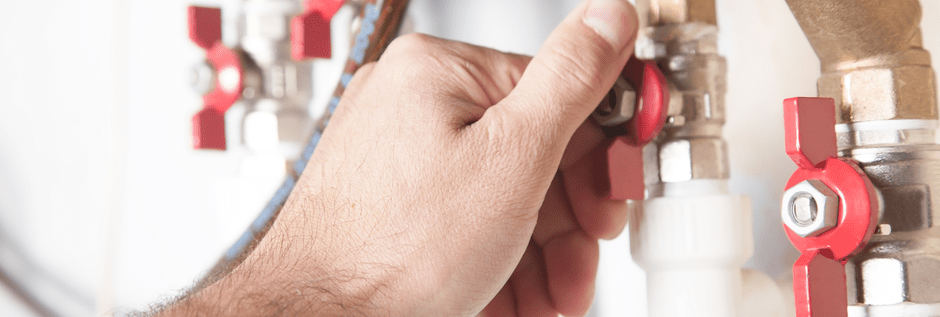Do you know where your home's gas shut-off valve is?
If you use natural gas, it’s important to know where your gas shut-off valve is.

Key tips to remember
- Every gas appliance has a shut-off valve
- Most homes have a homeside shut-off valve
- Most homes also have a streetside shut-off valve
- Be familiar with every gas shut-off valve in your home
- In emergencies, shut off the gas, get out of the home, and call the gas company
Do you know where are gas meters usually located, and is your gas valve on or off? Is it easy to tell? Not everyone knows how to turn on gas meter valves, much less locate them, but they really should. Typically, there are meters and valves both outside and inside the home, but you need to know where to look. Knowing precisely where your natural gas shut-off valve is located is a basic safety precaution that any homeowner should take care to determine.
A gas meter shut-off valve is your go-to in emergencies, like when you smell or hear gas escaping, find a break in the line, or otherwise have reason to suspect a gas leak. Knowing when to leave your gas valve open or closed is an important decision to make, and if you suspect danger, the answer is to turn the valve to the off position. Much like a propane tank shut-off valve, a gas shut-off valve for stoves controls the flow of natural gas to the appliance and must be disengaged before changing the tank (propane) or changing the appliance (when installing a new stove). A gas shut-off valve fireplace edition is located in a different area but works the same.
Most homes have primary gas shut-off valves, as well as shut-off valves for each major gas appliance. Turn off a main shut-off valve only in emergencies while calling the gas company to report your concerns. In comparison with the main shut-off valve, your gas-powered appliances are likely to require you to turn off the gas more often. Whenever you move, service or replace these appliances, their gas-supply valves need to be closed. Hopefully, these scenarios will happen a lot more often than gas-leak emergencies in your home!
Systems variations
Not all natural gas systems are the same, and the location and description of a main gas shut-off valve depends on when it was installed and will vary according to where you live, how old your home is, and what your local codes require. Some older homes don’t even have a houseside gas shut-off valve. That said, most gas meters and shut-off valves are in or around the front or side of a building, at times within some sort of box or enclosure but often exposed to the weather. Buildings such as apartments that contain multiple residences will have shut-off valves and meters for each unit, as well as a master valve to shut off gas for an entire building. Some newer homes have high-pressure systems identified by a copper pipe running from the meter into the house. These newer systems feature an inside main shut-off valve with a saucer-shaped regulator.
Find the valve
Most homes have two shut-off valves for the whole residence. One is for the homeowners, known as the houseside valve. The other is intended for use by the gas company, known as the streetside valve. Both can stop all gas flow to the home. You can usually spot the houseside valve near the black iron pipe directing gas into the home. The streetside valve, which should be used only if there’s a problem with the houseside valve, is typically found outside near the gas meter. The houseside valve appears on the line before it alters course significantly or reaches a “T” in the pipeline. When the lever is set to the on position, it will align in parallel with the black supply pipe. To turn this valve to the off position, turn it enough to make the handle perpendicular to the pipe, creating a right angle.
If there’s a problem with this valve, locate the streetside valve. Like the houseside valve, this valve is in the open position when the nub aligns in parallel with the pipe, and it’s closed when the nub is turned perpendicular to the pipe with a wrench. It’s a good idea to keep a wrench handy near this streetside valve in case of emergency. Some people choose to hang one on a wire near the valve and leave it outside. Others just remember to grab a wrench from a kitchen drawer filled with commonly used tools when running out to the streetside valve in the event of a gas-line emergency.
Turn off the gas
If you’re in an emergency situation and are sure the flow of gas into your home needs to stop, use the lever on the houseside valve to turn off the flow. Keep in mind that it could mean being without gas for at least a couple of hours and will take a visit from the gas company to turn it back on. It may take a while for the remaining gas in the line to escape. After several minutes, you should be able to confirm that gas is no longer flowing into the home.
Make sure it’s off
To double-check and be certain that you’ve successfully turned off the gas, make sure the houseside valve is set to the perpendicular position in relation to the pipe. If you still hear gas flowing, check all pilot lights to make sure they’re out. Keep in mind that many newer gas appliances no longer have pilot lights. If still uncertain about whether the gas is off, leave the home and call the gas company. On older appliance models, the gas company needs to relight pilot lights once the problem has been solved and gas has been restored to the home.
Find each gas appliance’s valve
If you’re having an issue with a single appliance, it could be unnecessary to turn off the entire gas flow to your home. Each appliance that uses gas has its own gas shut-off valve, and in many instances, an emergency can be resolved by shutting off the gas flow to a single appliance instead. Make sure you examine each of your gas appliances carefully to find the shut-off valve, typically found in-line and 6 feet or less behind, next to or near the bottom of the appliance . Spend a day reviewing the manuals of each gas appliance, locating the valves, and increasing your awareness of the gas shut-off valve placement. Usually, these valves function identically to the other valves we described; turning them perpendicularly from the gas line or pipe will interrupt the flow.
A final word on emergencies
Shutting off the gas to the home isn’t always the best idea for handling an emergency. Gas can become trapped inside a house and ignite with a spark caused by something as simple as a light switch, cellphone or static in your clothes. If you have an idea of where the leak is happening and can turn off the gas at the appliance valve, this is ideal. Then leave the home and call the gas company. Safety is always preferable to taking chances with flammable gas that can cause an explosion. A good rule of thumb is to never turn off the gas at any valve unless you hear or smell it, spot a broken line, or have other reasons to suspect a gas leak, and don’t try to turn it back on by yourself. Anytime you are concerned enough to turn off the gas, leave your home and call the gas company to diagnose the scene and restore the gas for you before returning to your home.
Thanks for reading our post about gas shut-off valves. Hopefully, it was helpful and informative, but it’s merely one of many! While you’re here, you might also be interested in our posts on fall home maintenance, and whether home warranties cover furnaces or fireplaces. You might also enjoy our insights and tips on disaster-proofing your home with maintenance and repairs, by prepping for wildfires, floods, hurricanes and earthquakes, or by improving your readiness for tornadoes, blizzards, lightning, drought and extreme heat. It’s never a bad time to be prepared!
The information in this article is intended to provide guidance on the proper maintenance and care of systems and appliances in the home. Not all of the topics mentioned are covered by our home warranty or maintenance plans. Please review your home warranty contract carefully to understand your coverage.



